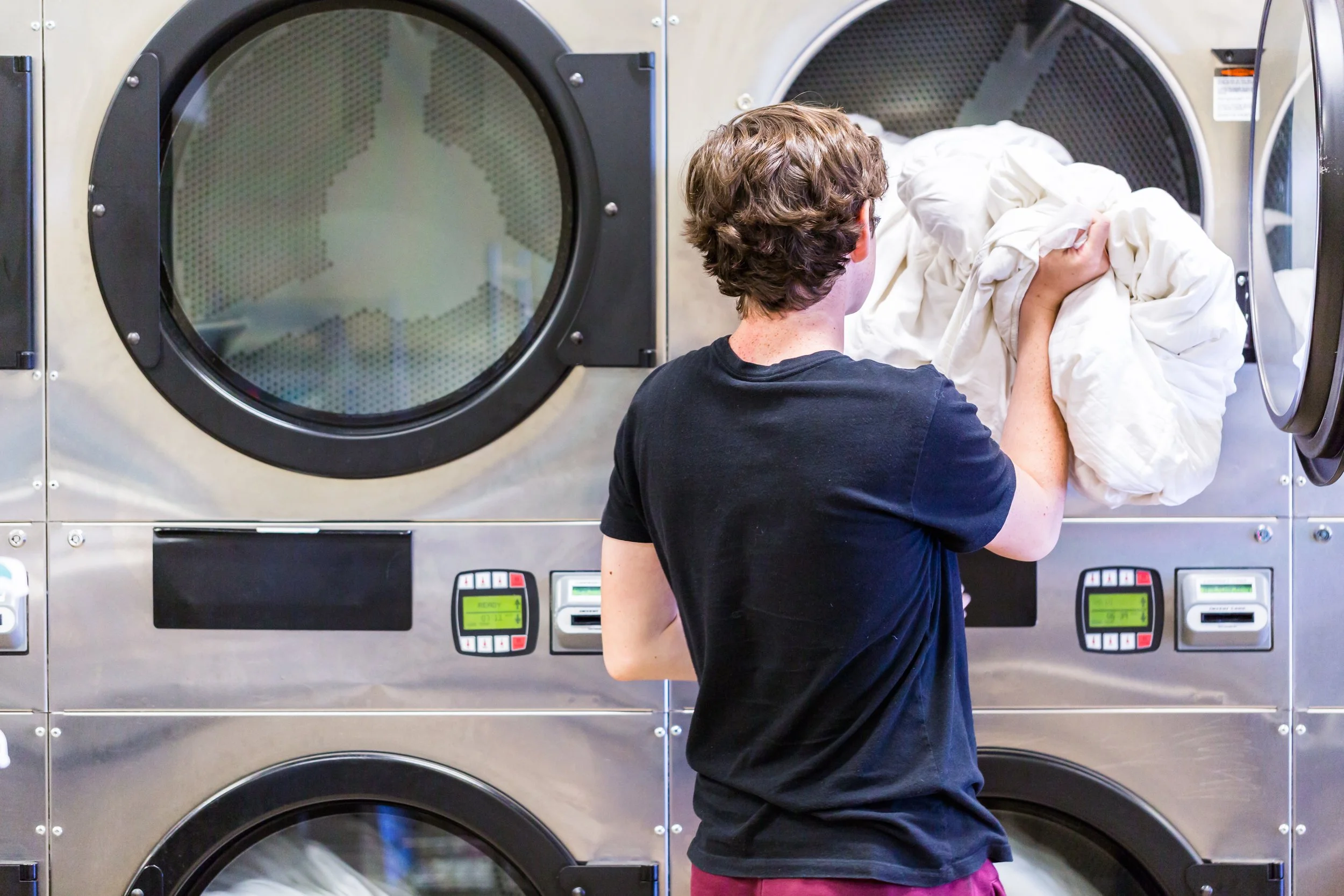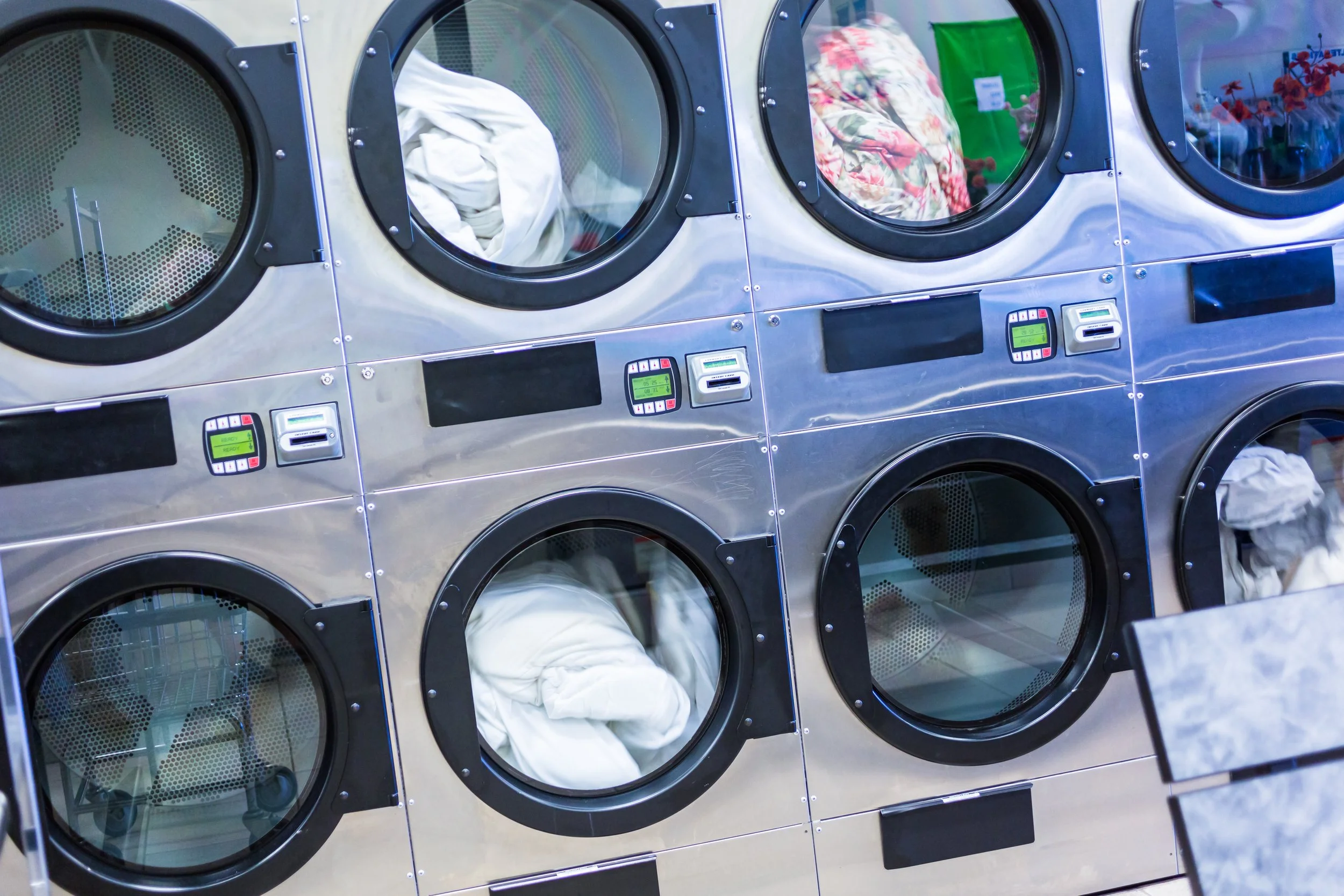In the modern era of convenience, commercial laundromats have emerged as a beacon of time-saving solutions in urban and suburban communities. The wash, dry, and fold model, a particularly popular service offering, relieves the burden on busy individuals and businesses and assures aspiring entrepreneurs of a promising business opportunity.
Suppose you’re considering entering the commercial laundry business or want to understand how it works. This comprehensive guide will cover key aspects, including equipment, financing, operational needs, target markets, and ideal neighbourhoods.
While Wash, Dry, and Fold (WDF) laundromats and dry cleaning businesses deal with laundry, they fundamentally differ in process, purpose, equipment, and the garments they handle.
Here’s a breakdown of the key differences:
🧺 1. Dry Cleaning Process
Wash, Dry & Fold (WDF)
Uses water and detergents.
Clothes are washed in commercial washers, dried in dryers, folded, and bagged.
Same process as what you’d do at home — just done professionally and in bulk.
Dry Cleaning
Chemical solvents (usually perchloroethylene or “perc”) are used instead of water.
Ideal for fabrics that can’t handle water or machine agitation.
Items are cleaned, steamed/pressed, and returned on hangers.
👚 2. Clothing Types Handled
WDF Services
Everyday wear: T-shirts, jeans, socks, underwear, gym clothes, linens, towels.
Typically, machine-washable items have no special care instructions.
Dry Cleaning
Delicate, high-maintenance garments: suits, silk blouses, dresses, wool coats, some uniforms.
Anything labeled “Dry Clean Only.”
⚙️ 3. Equipment Used
WDF Laundromats
Commercial washers & dryers (like Speed Queen, Dexter, and Maytag).
Folding tables, detergent dispensers.
Sometimes, it includes pickup/delivery and POS software.
Dry Cleaners
Dry cleaning machines (closed-loop systems using solvents).
Steam presses, spotting boards, and conveyors for wrinkle removal and fine treatment.
Specialised stain removal and cleaning chemicals.
💵 4. Pricing
WDF
Charged per pound (usually $1.25–$2.95/lb).
More affordable and faster.
Bulk-based — great for families or weekly laundry service.
Dry Cleaning
Charged per item (e.g., $10–$20 per suit jacket).
More expensive due to special handling and chemicals.
🧑💼 5. Target Market / Use Case
Wash, Dry & Fold
Every day, consumers who are too busy to do laundry.
Airbnb/short-term rental owners.
Small businesses with towels, uniforms, etc.
Dry Cleaning
Professionals needing pressed suits/dresses.
Special occasions (weddings, formal wear).
Delicate or designer clothes.
🧾 6. Turnaround Time
WDF
Often same-day or next-day service.
Can be offered on-demand or by subscription.
Dry Cleaning
Typically 1–3 days, depending on the service. Articles are often sent out for servicing.
🏭 Where Do Dry Cleaners Send Clothes?
1. Centralised Dry Cleaning Plants
Extensive industrial facilities have high-capacity dry cleaning machines, presses, and finishing equipment.
Independent or chain dry cleaners often partner with these plants instead of buying their own machines.
Clothes are picked up, cleaned, pressed, and returned to the storefront.
2. Franchise or Network Facilities
Chains like Lapels, Martinizing, Tide Cleaners, or CD One Price Cleaners operate hub-and-spoke models, where satellite drop-off locations send clothes to a central “hub.”
It keeps costs lower and quality more consistent across locations.
3. Speciality Cleaning Partners
Some cleaners outsource specific items to niche vendors, including:
Wedding gown preservation services
Leather and suede treatment centres
Rug and curtain cleaners
Fire and smoke restoration companies
🚛 How Does the Process Work?
Customer Drop-Off
You bring your clothes to a retail storefront or kiosk.
Sorting and Tagging
Items are inspected and barcoded or tagged for tracking.
Transport to Plant
A delivery van or courier picks up clothes and drives them to the centralized plant (usually overnight or early morning).
Cleaning and Pressing
The plant cleans, presses, and inspects each item.
Return to Store
Items are packaged, hung, and delivered back for customer pickup, often within 1–3 business days.
🏷️ Why Use a Third-Party Plant?
Cost Savings: No need for expensive dry cleaning equipment or chemical handling.
Space Efficiency: Storefronts can be smaller and focus on customer service.
Scalability: One plant can service dozens of drop-off locations.
🤝 Want to Start a Wash & Fold with Dry Cleaning Drop-Off?
Many wash, dry, and fold laundromats add “dry cleaning drop-off” as a revenue booster by partnering with a local dry cleaner or plant. You wouldn’t do the dry cleaning yourself—you handle intake, billing, and customer service.
I. Overview of Commercial Laundromats
Commercial Laundromat
A commercial laundromat, particularly those offering wash, dry, and fold services, provides customers with convenient laundry solutions. These facilities typically operate on a self-service model, but many are now expanding into full-service operations, including pick-up and delivery for residential and commercial clients.
Key Services Offered:
Self-Service Laundry
Drop-Off Wash, Dry & Fold
Pick-Up & Delivery Service via compact panel van
Commercial Account Services (e.g., hotels, gyms)
Vending Services (detergent, snacks)
Dry Cleaning (outsourced or onsite)
II. Equipment Needed for a Commercial Laundromat
The heart of any laundromat is its machinery. There are almost a dozen established commercial brands. Here’s a breakdown of the essential equipment:
1. Washers
Top Load Washers (less efficient, but cheaper)
Front Load Washers (energy and water-efficient)
High-capacity washers (for large loads or commercial accounts)
Washer Extractors (high-speed spinning to reduce drying time)
2. Dryers
Single Stack Dryers (individual units)
Stacked Dryers (space-saving)
Large-capacity dryers (for bedding, uniforms, etc.)
3. Folding Stations and Tables
Stainless steel or laminate surfaces
Optional heated folding tables for pressing
4. Point-of-Sale (POS) Systems
Accepts coins, credit/debit, mobile apps
Loyalty programs and CRM integration
5. Change Machines and Vending Machines
Coin dispensers
Soap and softener vending machines
6. Laundry Carts and Racks
For customer and staff use
Essential for workflow in wash & fold service
7. Water Heaters and Boilers
Commercial-grade water heating systems
Energy-efficient or tankless options
III. Utility and Fuel Requirements
Laundry equipment consumes a significant amount of energy and water. Choosing the right fuel source can significantly impact operational efficiency.
Electric vs. Gas
Note: Gas-powered machines are typically preferred in high-volume laundromats due to speed and efficiency, though electric models are easier to install.
IV. Setup and Layout Planning
1. Site Selection
Minimum 1,000 - 3,000+ sq. ft. depending on scale
Proximity to residential areas or apartment complexes
Easy parking and street visibility
2. Interior Layout
Open design for visibility and safety
Clear separation between self-service and employee-only areas
Designated folding and waiting areas
3. Plumbing & Ventilation
High-capacity water supply lines
Drainage systems capable of handling large volumes
Proper dryer venting to avoid fire hazards
4. Security & Automation
Wi-Fi or wired cameras
Automated locks and doors
Fire suppression systems
V. Commercial Financing and Working Capital
Starting a laundromat can be capital-intensive. The average startup cost ranges from $200,000 to $500,000 for a new facility, depending on size and location.
1. Financing Options
SBA Loans (Small Business Administration)
Low-interest, long-term financing
Good for first-time entrepreneurs
Equipment Financing
Spread cost over time
Up to 100% of equipment value
Business Lines of Credit
Flexible short-term funding
Ideal for inventory and staffing gaps
Leasing Equipment
Lower upfront cost
Useful for fast scalability
2. Working Capital Needs
Payroll
Detergents and packaging materials
Marketing and software subscriptions
Utility bills (water, gas, electric)
Repairs and maintenance
3. Financial Tips
Monitor utility costs closely
Upsell services like folding or express delivery
Diversify income streams with vending and commercial contracts
VI. Target Neighborhoods for Success
The success of a laundromat is highly dependent on your strategic decisions, particularly the location. High-performing laundromats are usually in areas with high population density, limited in-home laundry access, and high foot traffic or transit routes.
1. High Population Density
Urban centers
Apartment-heavy neighbourhoods
College campuses
2. Limited In-Home Laundry Access
Older buildings without washer/dryer hookups
Low-to-mid-income areas
3. High Foot Traffic or Transit Routes
Near bus stops, metro lines
Strip malls and shopping centres
Top Neighborhood Types:
Inner-city or downtown districts
Near public housing and Section 8 developments
College towns and student housing zones
Tourist areas with short-term rentals
Industrial zones with a need for uniform Cleaning
VII. Types of Commercial Laundry Accounts
Offering commercial services is a significant revenue booster. These contracts bring in consistent, bulk business. Typical commercial clients include:
1. Hospitality Industry
Hotels and motels
Vacation rentals
Airbnb operators
2. Medical and Health Care Facilities
Clinics
Hospitals
Dental offices
Assisted living facilities
3. Fitness and Wellness
Gyms
Yoga studios
Massage parlors
4. Restaurants and Food Services
Linen and apron services
Tablecloth and napkin cleaning
5. Educational Institutions
Daycares
Schools
Universities
6. Government and Public Services
Fire departments
Correctional facilities
Military contracts
VIII. Wash, Dry, and Fold Operations
This full-service offering turns a laundromat into an actual service-based business.
1. How It Works:
The customer drops off dirty laundry
Staff sorts, washes, dries, folds, and bags
Optional delivery or pickup is available
2. Workflow Efficiency
Colour-coded bins for sorting
Tagging system for identification
Conveyor belts or shelves for batch processing
3. Pricing Model
Priced per pound ($1.25–$2.95/lb average)
Rush orders command premium fees
Monthly billing for recurring accounts
4. Software Tools
Route management (for delivery)
CRM & customer database
Order tracking and invoicing
IX. Marketing and Customer Retention
1. Digital Marketing
SEO-optimized website
Google My Business profile
Yelp and review platforms
2. Social Media
Before/after photos
Testimonials
Local partnerships
3. Loyalty Programs
Points per visit
Punch cards
Monthly subscription for unlimited services
4. Community Engagement
Sponsor local events
Partner with housing authorities
Offer promotions for first responders or students
X. Common Challenges and Solutions
XI. Future of the Laundromat Industry
The laundromat industry is evolving, and future success will come to those who innovate. Trends like eco-friendly detergents, smart lockers, 24/7 access with security monitoring, and app-based scheduling are redefining the customer experience.
Key innovations include:
IoT-Connected Machines
Dynamic Pricing Based on Demand
Automated Folding Systems
Subscription-Based Laundry Plans
Conclusion
Commercial dry cleaning and laundromats offering wash, dry, and fold services are not just a solid business opportunity but a promising venture with diverse income streams and stable demand. With the right mix of strategic location, efficient equipment, proper financing, and modern marketing, you can build a profitable and scalable operation, encouraging you to embark on this journey with optimism about the potential for diverse income streams.
Whether you’re looking to serve time-starved professionals or build long-term contracts with local businesses, the laundry industry remains a reliable, recession-resistant market with room for innovation and growth. This stability and growth potential should instill confidence in your investment.
Commercial Financing Now ® is a Money Service Business (MSB) operating as a Non-Bank Financial Institution (NBFI) that abides by Anti-Money Laundering (AML) Regulations. These policies and procedures are internally published and meet reporting requirements while considering sanctions screening and transactional monitoring.
Commercial Finance Now does not provide tax, legal, or accounting advice. This post has been drafted for informational purposes only and is not intended to provide, and should not be relied on for, tax, legal, or accounting advice. You should consult your tax, legal, and accounting advisors before considering any tax treatments.




